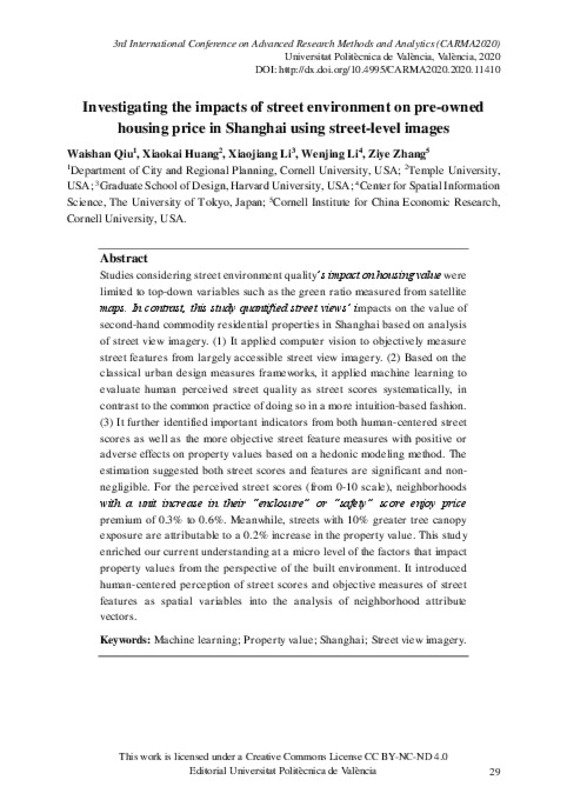JavaScript is disabled for your browser. Some features of this site may not work without it.
Buscar en RiuNet
Listar
Mi cuenta
Estadísticas
Ayuda RiuNet
Admin. UPV
Investigating the impacts of street environment on pre-owned housing price in Shanghai using street-level images
Mostrar el registro sencillo del ítem
Ficheros en el ítem
| dc.contributor.author | Qiu, Waishan
|
es_ES |
| dc.contributor.author | Huang, Xiaokai
|
es_ES |
| dc.contributor.author | Li, Xiaojiang
|
es_ES |
| dc.contributor.author | Li, Wenjing
|
es_ES |
| dc.contributor.author | Zhang, Ziye
|
es_ES |
| dc.coverage.spatial | east=121.473701; north=31.230416; name=200 Ren Min Da Dao, Ren Min Guang Chang, Huangpu Qu, Shanghai Shi, Xina, 200000 | es_ES |
| dc.date.accessioned | 2020-07-30T11:02:39Z | |
| dc.date.available | 2020-07-30T11:02:39Z | |
| dc.date.issued | 2020-07-02 | |
| dc.identifier.isbn | 9788490488324 | |
| dc.identifier.uri | http://hdl.handle.net/10251/148995 | |
| dc.description.abstract | [EN] Studies considering street environment quality’s impact on housing value were limited to top-down variables such as the green ratio measured from satellite maps. In contrast, this study quantified street views’ impacts on the value of second-hand commodity residential properties in Shanghai based on analysis of street view imagery. (1) It applied computer vision to objectively measure street features from largely accessible street view imagery. (2) Based on the classical urban design measures frameworks, it applied machine learning to evaluate human perceived street quality as street scores systematically, in contrast to the common practice of doing so in a more intuition-based fashion. (3) It further identified important indicators from both human-centered street scores as well as the more objective street feature measures with positive or adverse effects on property values based on a hedonic modeling method. The estimation suggested both street scores and features are significant and nonnegligible. For the perceived street scores (from 0-10 scale), neighborhoods with a unit increase in their “enclosure” or “safety” score enjoy price premium of 0.3% to 0.6%. Meanwhile, streets with 10% greater tree canopy exposure are attributable to a 0.2% increase in the property value. This study enriched our current understanding at a micro level of the factors that impact property values from the perspective of the built environment. It introduced human-centered perception of street scores and objective measures of street features as spatial variables into the analysis of neighborhood attribute vectors. | es_ES |
| dc.language | Inglés | es_ES |
| dc.publisher | Editorial Universitat Politècnica de València | es_ES |
| dc.rights | Reconocimiento - No comercial - Sin obra derivada (by-nc-nd) | es_ES |
| dc.subject | Web data | es_ES |
| dc.subject | Internet data | es_ES |
| dc.subject | Big data | es_ES |
| dc.subject | Qca | es_ES |
| dc.subject | Pls | es_ES |
| dc.subject | Sem | es_ES |
| dc.subject | Conference | es_ES |
| dc.subject | Machine learning | es_ES |
| dc.subject | Property value | es_ES |
| dc.subject | Shanghai | es_ES |
| dc.subject | Street view imagery. | es_ES |
| dc.title | Investigating the impacts of street environment on pre-owned housing price in Shanghai using street-level images | es_ES |
| dc.type | Capítulo de libro | es_ES |
| dc.type | Comunicación en congreso | es_ES |
| dc.identifier.doi | 10.4995/CARMA2020.2020.11410 | |
| dc.rights.accessRights | Abierto | es_ES |
| dc.description.bibliographicCitation | Qiu, W.; Huang, X.; Li, X.; Li, W.; Zhang, Z. (2020). Investigating the impacts of street environment on pre-owned housing price in Shanghai using street-level images. Editorial Universitat Politècnica de València. 29-39. https://doi.org/10.4995/CARMA2020.2020.11410 | es_ES |
| dc.description.accrualMethod | OCS | es_ES |
| dc.relation.conferencename | CARMA 2020 - 3rd International Conference on Advanced Research Methods and Analytics | es_ES |
| dc.relation.conferencedate | Julio 08-09,2020 | es_ES |
| dc.relation.conferenceplace | Valencia, Spain | es_ES |
| dc.relation.publisherversion | http://ocs.editorial.upv.es/index.php/CARMA/CARMA2020/paper/view/11410 | es_ES |
| dc.description.upvformatpinicio | 29 | es_ES |
| dc.description.upvformatpfin | 39 | es_ES |
| dc.type.version | info:eu-repo/semantics/publishedVersion | es_ES |
| dc.relation.pasarela | OCS\11410 | es_ES |








